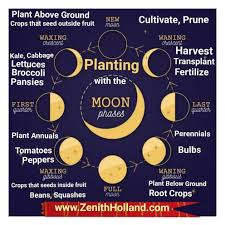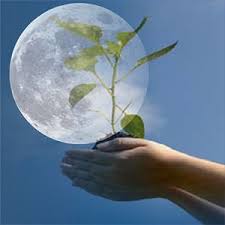Gardening by the Moon works according to the age-old belief that phases of the Moon affect plant growth, it’s a great way to help plan your above and below ground crops.
Plant annual flowers and vegetables that bear crops above ground during the light or waxing of the Moon. (waxing of the moon is any time after new moon and before full moon, when the moon is getting larger every night)
Plant flowering bulbs, biennial and perennial flowers, and vegetables that bear crops below ground during the dark, or waning of the Moon – resulting in a larger, tastier harvest. (waning of the moon is when the moon is getting smaller every night)
Frost occurring in the dark of the Moon kills fruit buds and blossoms, but frost in the light of the Moon will not.
Corn planted under a waning Moon grows slower but yields larger ears.
A bright first Moon promises rain and a bountiful harvest; a red-tinted Moon means a dry year.
According to folklore, the period from the full Moon through the last quarter of the Moon is the best time for killing weeds, thinning, pruning, mowing, cutting timber, and planting below ground crops.
Days following both the new and full Moons are most likely to be rainy or stormy.
Many livestock farmers believe changes can be positive during the full moon, as well. They’ll use the full moon to move animals from one pasture to another, change feed during a full moon and change hay cuttings during a full moon. In fact, weaning colts on a full moon often helps lighten the stress in both mare and colt. And we are lucky enough to have full Moons in every month of the year …
January
In Native American and early Colonial times, the full Moon for January was called the Full Wolf Moon because wolves tended to howl more often at this time. Traditionally, the January Moon is also knows as the Old Moon. To some Native American tribes, this was the Snow Moon, but most applied that name to the next full Moon, in February.
February
Traditionally, the Moon we see in February is called the Snow Moon because usually the heaviest snows fall in February. This name dates back to the Native Americans during Colonial times when the Moons were a way of tracking the seasons. On average, February is the USA’s snowiest month, according to data from the National Weather Service. Hunting becomes very difficult, so some Native American tribes call this the Hunger Moon.
March
In March, the full Moon was traditionally called the Full Worm Moon by Native Americans who used lunar phases to track the season. Colonial Americans also used these names, especially those of the local Algonquin tribes who lived between new England and Lake Superior At the time of this Moon, the ground begins to soften enough for earthworm casts to reappear, inviting the return of robins and migrating birds – a true sign of spring. Roots start to push their way up through the soil, and the Earth experiences a rebirth as it awakens from its winter slumber.
April
April’s full Moon, the Full Pink Moon heralds the appearance of the “moss pink”, or wild ground phlox – one of the first spring flowers. It is also knows as the Sprouting Grass Moon, the Egg Moon, and the Fish Moon. These names were used by early Colonial Americans – who learned the names from the local Native Americans; time was not recorded by using the months of the Julian or Gregorian calendar. Many tribes kept track of time by observing the seasons and lunar months, although there was much variability.
May
The May Moon marked a time of increasing fertility, with temperatures warm enough for safely bearing young, a near end to late frosts, and plants in bloom. Depending upon the Native American tribe, May’s full Moon was called the Full Flower Moon, as well as Mother’s Moon, Milk Moon, and Corn Planting Moon.
June
The month of June’s full Moon’s name is the Full Strawberry Moon and got its name because the Algonquin tribes knew it as a signal to gather ripening fruit. It was often knows as the Full Rose Moon or the Honey Moon in Europe.
July
July is the month of the Full Buck Moon. At this time, a buck’s antlers are in full growth mode. This full Moon was also known as the Thunder Moon because thunderstorms are so frequent during this month.
August
Some Native American tribes called the August Moon the Sturgeon Moon because they knew that the sturgeon of the Great Lakes and Lake Champlain were most readily caught during this full Moon. They also called August’s Moon the Full Green Corn Moon. Different tribes had different Moon name preferences. Other examples for August are: Wheat Cut Moon, Moon When All Things Ripen and Blueberry Moon.
September
The common September Moon name was the Full Corn Moon because it traditionally corresponds with the time of harvesting corn. It was also called the Barley Moon, as this is the time to harvest and thresh ripened barley. The full Moon that falls nearest to the equinox takes on the name “Harvest Moon” rather than its traditional name. This means that a Harvest Moon could occur in either September or October.
October
October’s Moon rises just after sunset and sets around sunrise, so this is the only night in the month when the Moon is in the sky all night long. Some Native American tribes referred to October’s Moon as the Full Hunter’s Moon, as it was the time to go hunting in preparation for winter. This full Moon is also called the Travel Moon and the Dying Grass Moon.
November
November’s full Moon is called the Beaver Moon by both the colonists and the Algonquin tribes. The Native Americans used the monthly Moons and nature’s signs as a sort of calendar to track the season. This was the month to set beaver traps before the swamps froze, to ensure a supply of warm winter furs. This November full Moon was also called the Full Frost Moon by other Native American tribes.
December
In Native American cultures which tracked the calendar by the Moons, December’s full Moon was known as the Full Cold Moon. It is fittingly associated with the month when the winter cold fastens its grip and the nights become long and dark. This full Moon is also called the Long Nights Moon because it occurs near the winter solstice – the day with the least amount of daylight.

